University Communication Report: Diagnostic Tools and Reflection
VerifiedAdded on 2020/03/16
|11
|3115
|46
Report
AI Summary
This report provides a self-reflective analysis of a student's business communication skills, utilizing five diagnostic tools to assess strengths and weaknesses. The student's score on each tool, including the Personal Report of Public Speaking Anxiety, Willingness to Listen, Talkaholic Scale, Personal Report of Intercultural Communication Apprehension, and Non-Verbal Immediacy Scale, are analyzed. Two key communication issues are identified: the student's introverted nature and negative non-verbal communication cues. The report includes reflections on two professional interactions where these challenges surfaced, followed by a literature review exploring relevant concepts like the spiral of silence, persuasive communication, and non-verbal communication theories. The literature review explores the importance of silence, non-verbal communication, and the influence of persuasion techniques. Finally, the report concludes with an action plan to address the identified communication issues and enhance professional effectiveness.
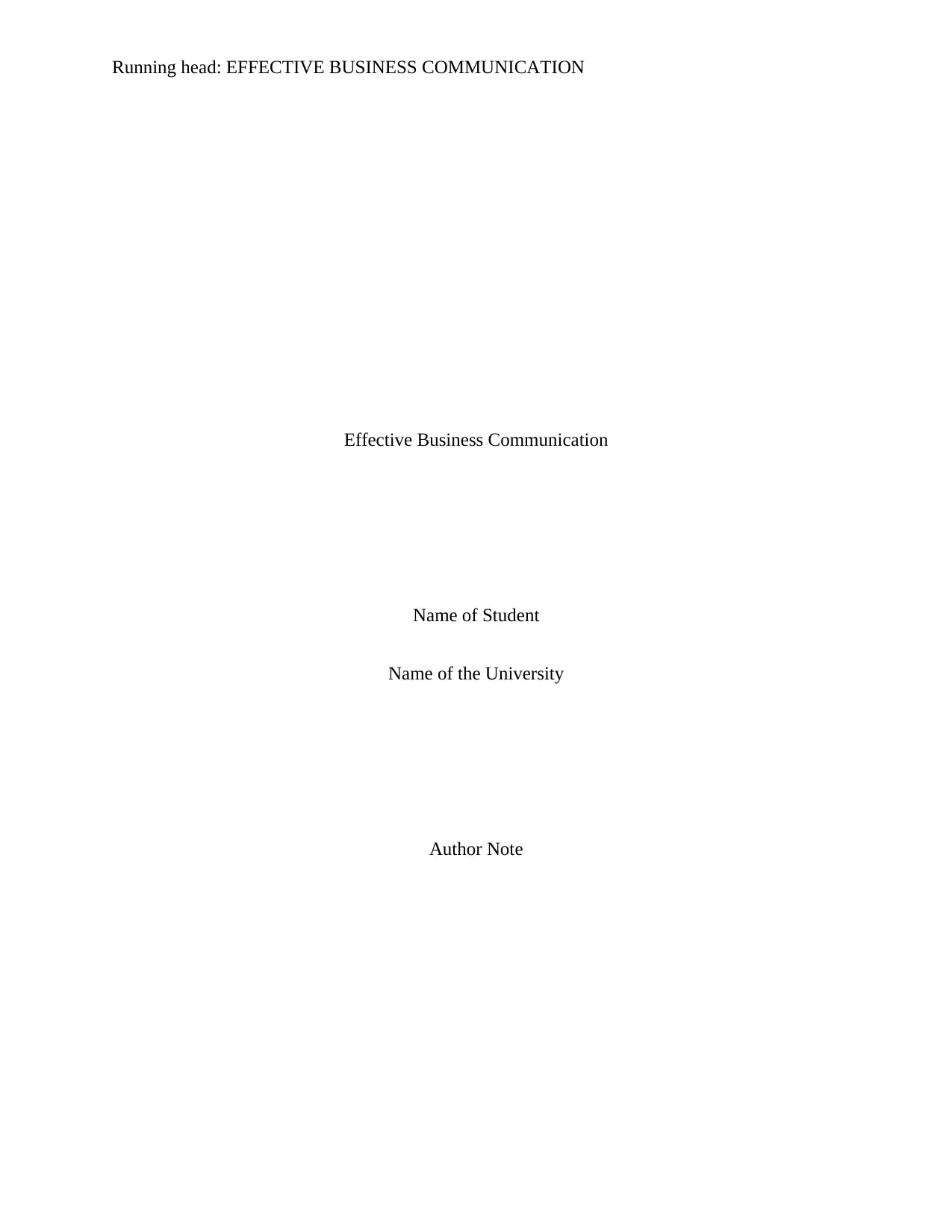
Running head: EFFECTIVE BUSINESS COMMUNICATION
Effective Business Communication
Name of Student
Name of the University
Author Note
Effective Business Communication
Name of Student
Name of the University
Author Note
Paraphrase This Document
Need a fresh take? Get an instant paraphrase of this document with our AI Paraphraser
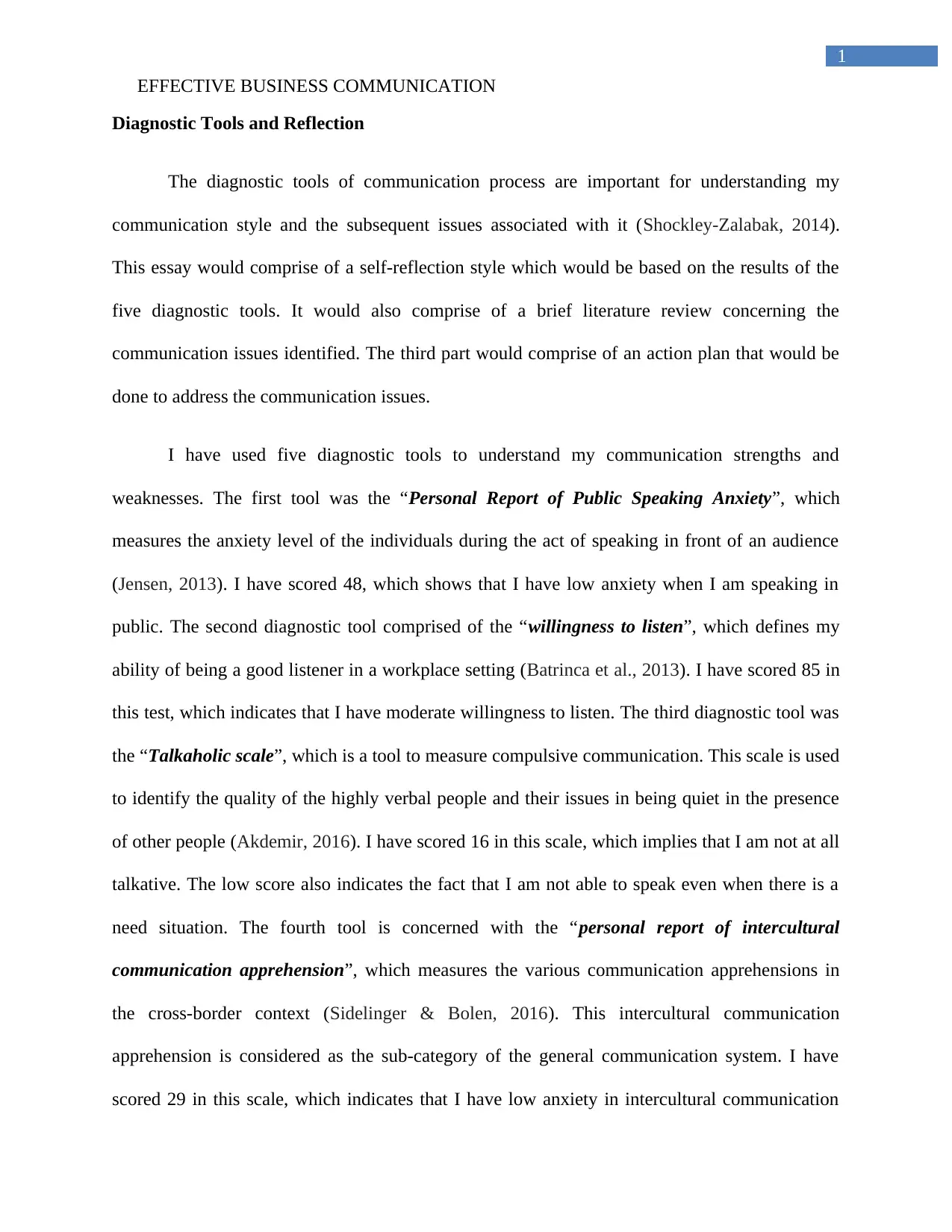
1
EFFECTIVE BUSINESS COMMUNICATION
Diagnostic Tools and Reflection
The diagnostic tools of communication process are important for understanding my
communication style and the subsequent issues associated with it (Shockley-Zalabak, 2014).
This essay would comprise of a self-reflection style which would be based on the results of the
five diagnostic tools. It would also comprise of a brief literature review concerning the
communication issues identified. The third part would comprise of an action plan that would be
done to address the communication issues.
I have used five diagnostic tools to understand my communication strengths and
weaknesses. The first tool was the “Personal Report of Public Speaking Anxiety”, which
measures the anxiety level of the individuals during the act of speaking in front of an audience
(Jensen, 2013). I have scored 48, which shows that I have low anxiety when I am speaking in
public. The second diagnostic tool comprised of the “willingness to listen”, which defines my
ability of being a good listener in a workplace setting (Batrinca et al., 2013). I have scored 85 in
this test, which indicates that I have moderate willingness to listen. The third diagnostic tool was
the “Talkaholic scale”, which is a tool to measure compulsive communication. This scale is used
to identify the quality of the highly verbal people and their issues in being quiet in the presence
of other people (Akdemir, 2016). I have scored 16 in this scale, which implies that I am not at all
talkative. The low score also indicates the fact that I am not able to speak even when there is a
need situation. The fourth tool is concerned with the “personal report of intercultural
communication apprehension”, which measures the various communication apprehensions in
the cross-border context (Sidelinger & Bolen, 2016). This intercultural communication
apprehension is considered as the sub-category of the general communication system. I have
scored 29 in this scale, which indicates that I have low anxiety in intercultural communication
EFFECTIVE BUSINESS COMMUNICATION
Diagnostic Tools and Reflection
The diagnostic tools of communication process are important for understanding my
communication style and the subsequent issues associated with it (Shockley-Zalabak, 2014).
This essay would comprise of a self-reflection style which would be based on the results of the
five diagnostic tools. It would also comprise of a brief literature review concerning the
communication issues identified. The third part would comprise of an action plan that would be
done to address the communication issues.
I have used five diagnostic tools to understand my communication strengths and
weaknesses. The first tool was the “Personal Report of Public Speaking Anxiety”, which
measures the anxiety level of the individuals during the act of speaking in front of an audience
(Jensen, 2013). I have scored 48, which shows that I have low anxiety when I am speaking in
public. The second diagnostic tool comprised of the “willingness to listen”, which defines my
ability of being a good listener in a workplace setting (Batrinca et al., 2013). I have scored 85 in
this test, which indicates that I have moderate willingness to listen. The third diagnostic tool was
the “Talkaholic scale”, which is a tool to measure compulsive communication. This scale is used
to identify the quality of the highly verbal people and their issues in being quiet in the presence
of other people (Akdemir, 2016). I have scored 16 in this scale, which implies that I am not at all
talkative. The low score also indicates the fact that I am not able to speak even when there is a
need situation. The fourth tool is concerned with the “personal report of intercultural
communication apprehension”, which measures the various communication apprehensions in
the cross-border context (Sidelinger & Bolen, 2016). This intercultural communication
apprehension is considered as the sub-category of the general communication system. I have
scored 29 in this scale, which indicates that I have low anxiety in intercultural communication
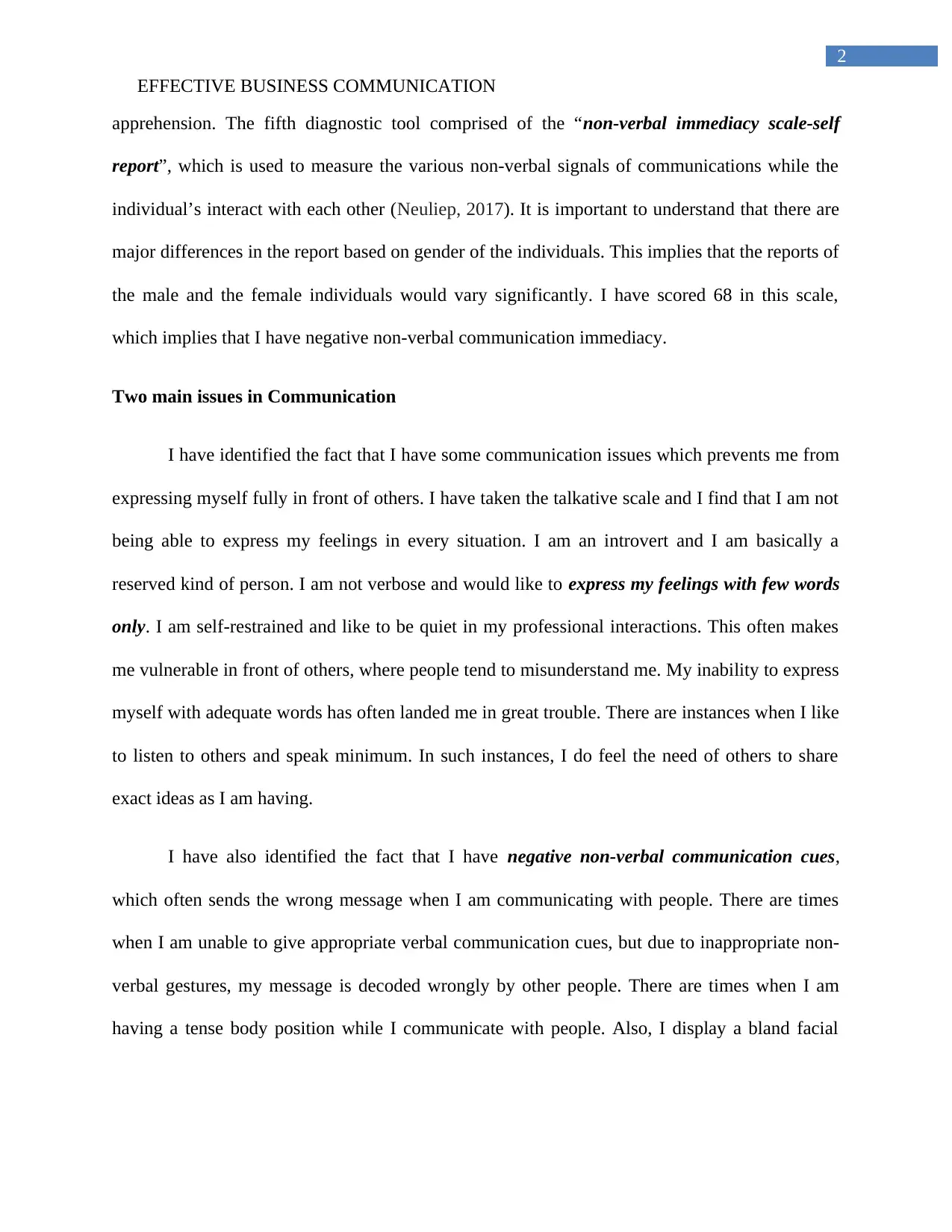
2
EFFECTIVE BUSINESS COMMUNICATION
apprehension. The fifth diagnostic tool comprised of the “non-verbal immediacy scale-self
report”, which is used to measure the various non-verbal signals of communications while the
individual’s interact with each other (Neuliep, 2017). It is important to understand that there are
major differences in the report based on gender of the individuals. This implies that the reports of
the male and the female individuals would vary significantly. I have scored 68 in this scale,
which implies that I have negative non-verbal communication immediacy.
Two main issues in Communication
I have identified the fact that I have some communication issues which prevents me from
expressing myself fully in front of others. I have taken the talkative scale and I find that I am not
being able to express my feelings in every situation. I am an introvert and I am basically a
reserved kind of person. I am not verbose and would like to express my feelings with few words
only. I am self-restrained and like to be quiet in my professional interactions. This often makes
me vulnerable in front of others, where people tend to misunderstand me. My inability to express
myself with adequate words has often landed me in great trouble. There are instances when I like
to listen to others and speak minimum. In such instances, I do feel the need of others to share
exact ideas as I am having.
I have also identified the fact that I have negative non-verbal communication cues,
which often sends the wrong message when I am communicating with people. There are times
when I am unable to give appropriate verbal communication cues, but due to inappropriate non-
verbal gestures, my message is decoded wrongly by other people. There are times when I am
having a tense body position while I communicate with people. Also, I display a bland facial
EFFECTIVE BUSINESS COMMUNICATION
apprehension. The fifth diagnostic tool comprised of the “non-verbal immediacy scale-self
report”, which is used to measure the various non-verbal signals of communications while the
individual’s interact with each other (Neuliep, 2017). It is important to understand that there are
major differences in the report based on gender of the individuals. This implies that the reports of
the male and the female individuals would vary significantly. I have scored 68 in this scale,
which implies that I have negative non-verbal communication immediacy.
Two main issues in Communication
I have identified the fact that I have some communication issues which prevents me from
expressing myself fully in front of others. I have taken the talkative scale and I find that I am not
being able to express my feelings in every situation. I am an introvert and I am basically a
reserved kind of person. I am not verbose and would like to express my feelings with few words
only. I am self-restrained and like to be quiet in my professional interactions. This often makes
me vulnerable in front of others, where people tend to misunderstand me. My inability to express
myself with adequate words has often landed me in great trouble. There are instances when I like
to listen to others and speak minimum. In such instances, I do feel the need of others to share
exact ideas as I am having.
I have also identified the fact that I have negative non-verbal communication cues,
which often sends the wrong message when I am communicating with people. There are times
when I am unable to give appropriate verbal communication cues, but due to inappropriate non-
verbal gestures, my message is decoded wrongly by other people. There are times when I am
having a tense body position while I communicate with people. Also, I display a bland facial
⊘ This is a preview!⊘
Do you want full access?
Subscribe today to unlock all pages.

Trusted by 1+ million students worldwide
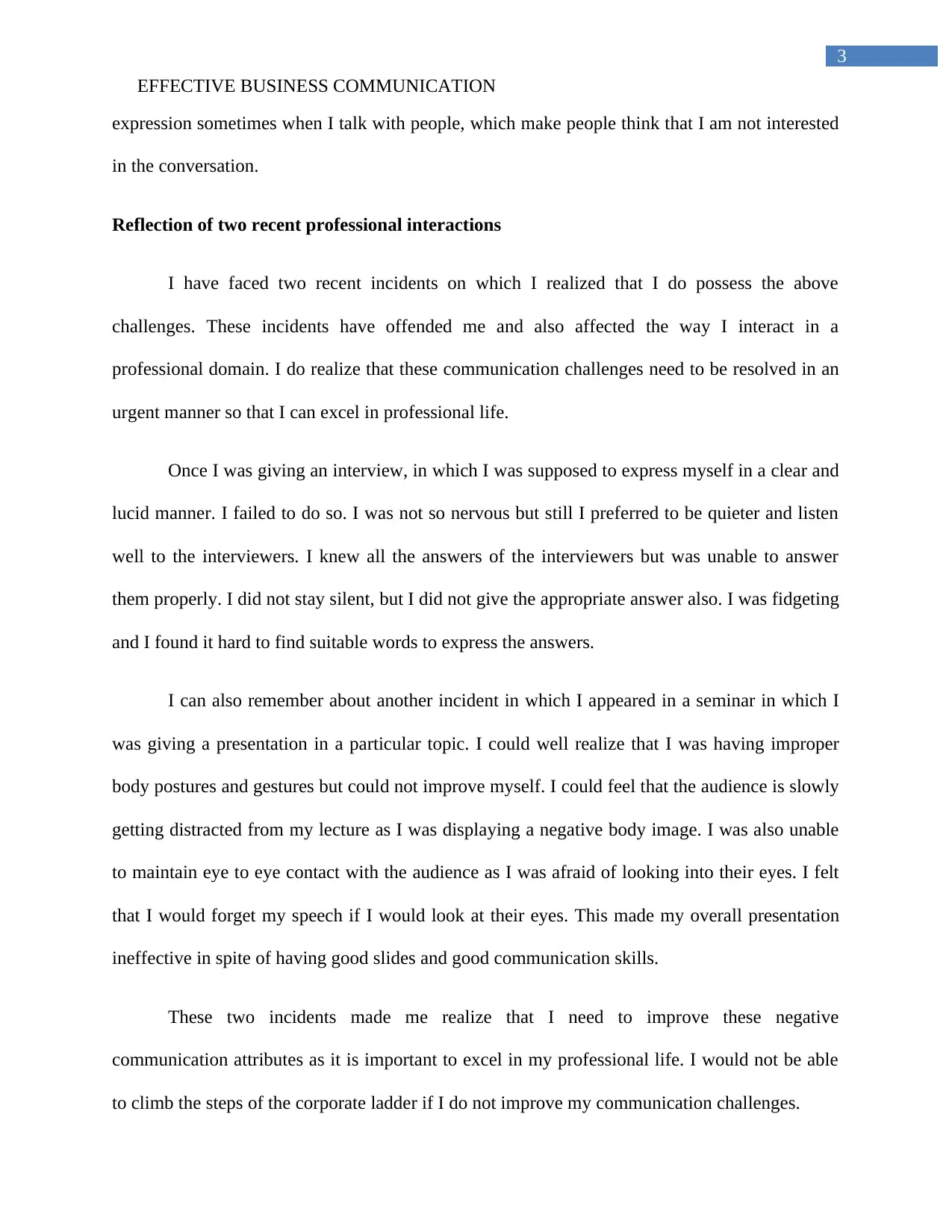
3
EFFECTIVE BUSINESS COMMUNICATION
expression sometimes when I talk with people, which make people think that I am not interested
in the conversation.
Reflection of two recent professional interactions
I have faced two recent incidents on which I realized that I do possess the above
challenges. These incidents have offended me and also affected the way I interact in a
professional domain. I do realize that these communication challenges need to be resolved in an
urgent manner so that I can excel in professional life.
Once I was giving an interview, in which I was supposed to express myself in a clear and
lucid manner. I failed to do so. I was not so nervous but still I preferred to be quieter and listen
well to the interviewers. I knew all the answers of the interviewers but was unable to answer
them properly. I did not stay silent, but I did not give the appropriate answer also. I was fidgeting
and I found it hard to find suitable words to express the answers.
I can also remember about another incident in which I appeared in a seminar in which I
was giving a presentation in a particular topic. I could well realize that I was having improper
body postures and gestures but could not improve myself. I could feel that the audience is slowly
getting distracted from my lecture as I was displaying a negative body image. I was also unable
to maintain eye to eye contact with the audience as I was afraid of looking into their eyes. I felt
that I would forget my speech if I would look at their eyes. This made my overall presentation
ineffective in spite of having good slides and good communication skills.
These two incidents made me realize that I need to improve these negative
communication attributes as it is important to excel in my professional life. I would not be able
to climb the steps of the corporate ladder if I do not improve my communication challenges.
EFFECTIVE BUSINESS COMMUNICATION
expression sometimes when I talk with people, which make people think that I am not interested
in the conversation.
Reflection of two recent professional interactions
I have faced two recent incidents on which I realized that I do possess the above
challenges. These incidents have offended me and also affected the way I interact in a
professional domain. I do realize that these communication challenges need to be resolved in an
urgent manner so that I can excel in professional life.
Once I was giving an interview, in which I was supposed to express myself in a clear and
lucid manner. I failed to do so. I was not so nervous but still I preferred to be quieter and listen
well to the interviewers. I knew all the answers of the interviewers but was unable to answer
them properly. I did not stay silent, but I did not give the appropriate answer also. I was fidgeting
and I found it hard to find suitable words to express the answers.
I can also remember about another incident in which I appeared in a seminar in which I
was giving a presentation in a particular topic. I could well realize that I was having improper
body postures and gestures but could not improve myself. I could feel that the audience is slowly
getting distracted from my lecture as I was displaying a negative body image. I was also unable
to maintain eye to eye contact with the audience as I was afraid of looking into their eyes. I felt
that I would forget my speech if I would look at their eyes. This made my overall presentation
ineffective in spite of having good slides and good communication skills.
These two incidents made me realize that I need to improve these negative
communication attributes as it is important to excel in my professional life. I would not be able
to climb the steps of the corporate ladder if I do not improve my communication challenges.
Paraphrase This Document
Need a fresh take? Get an instant paraphrase of this document with our AI Paraphraser

4
EFFECTIVE BUSINESS COMMUNICATION
Literature Review
As opined by Booher (2017), the intelligent people often prefer silence over those who
are verbose and they often wait for the people to say important things. These kinds of people are
often reluctant to use their mouth to communicate and instead they like to perform active
listening. These kinds of personalities are also considered as the introverts, who do not their
voices to be heard in public. These kinds of people often are busy in their own thinking process
and hence do not find the chance or opportunity to express their feelings (Berger & Iyengar,
2013). There are instances when they critically analyze every detail in the conversation and
hence they are not able to speak easily (Shockley-Zalabak, 2014). The quiet people often have
enough matter to say, but they may be unable to find actual words to express their feelings. They
do not have the habit of blabbering and they tend to absorb everything that is happening around
them.
As argued by Matthes and Arendt (2016), the “spiral of silence” theory is concerned with
the explanations that underline the fact why people do not like to speak on matters that actually
matters to them. This theory discusses the public opinion as the attitudes through which the
individuals are able to express themselves without the fear of making them lonely (Shockley-
Zalabak, 2014). There are most people that have the ability to identify the popular opinions at
given point of time and they tend to act accordingly. The spiral of silence theory is not bad in
every context and it can be well utilized in environments in which there is an alignment of the
public opinion towards tolerance (Clemente & Roulet, 2015). This theory can be well used in
instances when it is important to hide feelings of hate from public disclosures. However, there
are times, when this theory can act against the image and goodwill of an individual and there is a
resulting distraction from the same.
EFFECTIVE BUSINESS COMMUNICATION
Literature Review
As opined by Booher (2017), the intelligent people often prefer silence over those who
are verbose and they often wait for the people to say important things. These kinds of people are
often reluctant to use their mouth to communicate and instead they like to perform active
listening. These kinds of personalities are also considered as the introverts, who do not their
voices to be heard in public. These kinds of people often are busy in their own thinking process
and hence do not find the chance or opportunity to express their feelings (Berger & Iyengar,
2013). There are instances when they critically analyze every detail in the conversation and
hence they are not able to speak easily (Shockley-Zalabak, 2014). The quiet people often have
enough matter to say, but they may be unable to find actual words to express their feelings. They
do not have the habit of blabbering and they tend to absorb everything that is happening around
them.
As argued by Matthes and Arendt (2016), the “spiral of silence” theory is concerned with
the explanations that underline the fact why people do not like to speak on matters that actually
matters to them. This theory discusses the public opinion as the attitudes through which the
individuals are able to express themselves without the fear of making them lonely (Shockley-
Zalabak, 2014). There are most people that have the ability to identify the popular opinions at
given point of time and they tend to act accordingly. The spiral of silence theory is not bad in
every context and it can be well utilized in environments in which there is an alignment of the
public opinion towards tolerance (Clemente & Roulet, 2015). This theory can be well used in
instances when it is important to hide feelings of hate from public disclosures. However, there
are times, when this theory can act against the image and goodwill of an individual and there is a
resulting distraction from the same.
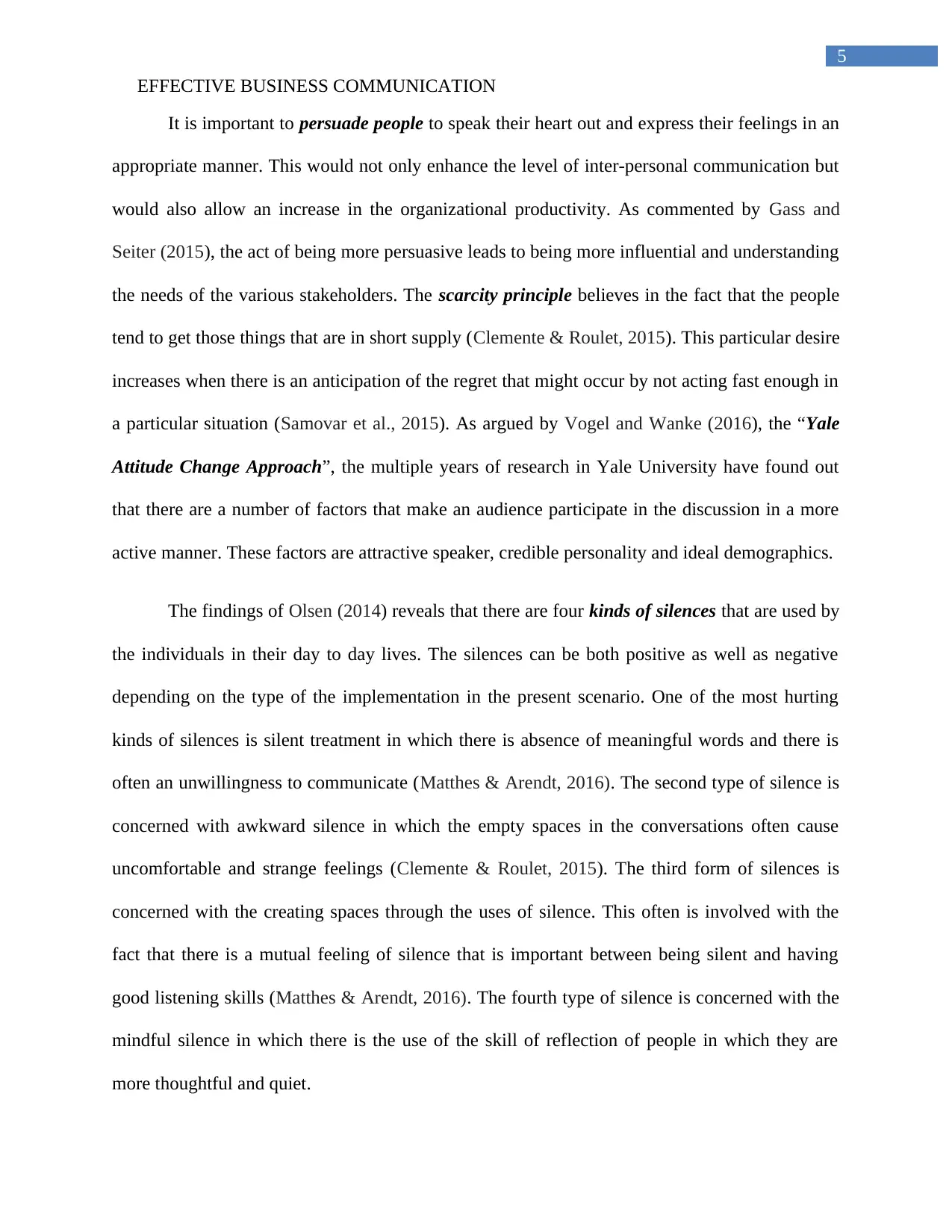
5
EFFECTIVE BUSINESS COMMUNICATION
It is important to persuade people to speak their heart out and express their feelings in an
appropriate manner. This would not only enhance the level of inter-personal communication but
would also allow an increase in the organizational productivity. As commented by Gass and
Seiter (2015), the act of being more persuasive leads to being more influential and understanding
the needs of the various stakeholders. The scarcity principle believes in the fact that the people
tend to get those things that are in short supply (Clemente & Roulet, 2015). This particular desire
increases when there is an anticipation of the regret that might occur by not acting fast enough in
a particular situation (Samovar et al., 2015). As argued by Vogel and Wanke (2016), the “Yale
Attitude Change Approach”, the multiple years of research in Yale University have found out
that there are a number of factors that make an audience participate in the discussion in a more
active manner. These factors are attractive speaker, credible personality and ideal demographics.
The findings of Olsen (2014) reveals that there are four kinds of silences that are used by
the individuals in their day to day lives. The silences can be both positive as well as negative
depending on the type of the implementation in the present scenario. One of the most hurting
kinds of silences is silent treatment in which there is absence of meaningful words and there is
often an unwillingness to communicate (Matthes & Arendt, 2016). The second type of silence is
concerned with awkward silence in which the empty spaces in the conversations often cause
uncomfortable and strange feelings (Clemente & Roulet, 2015). The third form of silences is
concerned with the creating spaces through the uses of silence. This often is involved with the
fact that there is a mutual feeling of silence that is important between being silent and having
good listening skills (Matthes & Arendt, 2016). The fourth type of silence is concerned with the
mindful silence in which there is the use of the skill of reflection of people in which they are
more thoughtful and quiet.
EFFECTIVE BUSINESS COMMUNICATION
It is important to persuade people to speak their heart out and express their feelings in an
appropriate manner. This would not only enhance the level of inter-personal communication but
would also allow an increase in the organizational productivity. As commented by Gass and
Seiter (2015), the act of being more persuasive leads to being more influential and understanding
the needs of the various stakeholders. The scarcity principle believes in the fact that the people
tend to get those things that are in short supply (Clemente & Roulet, 2015). This particular desire
increases when there is an anticipation of the regret that might occur by not acting fast enough in
a particular situation (Samovar et al., 2015). As argued by Vogel and Wanke (2016), the “Yale
Attitude Change Approach”, the multiple years of research in Yale University have found out
that there are a number of factors that make an audience participate in the discussion in a more
active manner. These factors are attractive speaker, credible personality and ideal demographics.
The findings of Olsen (2014) reveals that there are four kinds of silences that are used by
the individuals in their day to day lives. The silences can be both positive as well as negative
depending on the type of the implementation in the present scenario. One of the most hurting
kinds of silences is silent treatment in which there is absence of meaningful words and there is
often an unwillingness to communicate (Matthes & Arendt, 2016). The second type of silence is
concerned with awkward silence in which the empty spaces in the conversations often cause
uncomfortable and strange feelings (Clemente & Roulet, 2015). The third form of silences is
concerned with the creating spaces through the uses of silence. This often is involved with the
fact that there is a mutual feeling of silence that is important between being silent and having
good listening skills (Matthes & Arendt, 2016). The fourth type of silence is concerned with the
mindful silence in which there is the use of the skill of reflection of people in which they are
more thoughtful and quiet.
⊘ This is a preview!⊘
Do you want full access?
Subscribe today to unlock all pages.

Trusted by 1+ million students worldwide
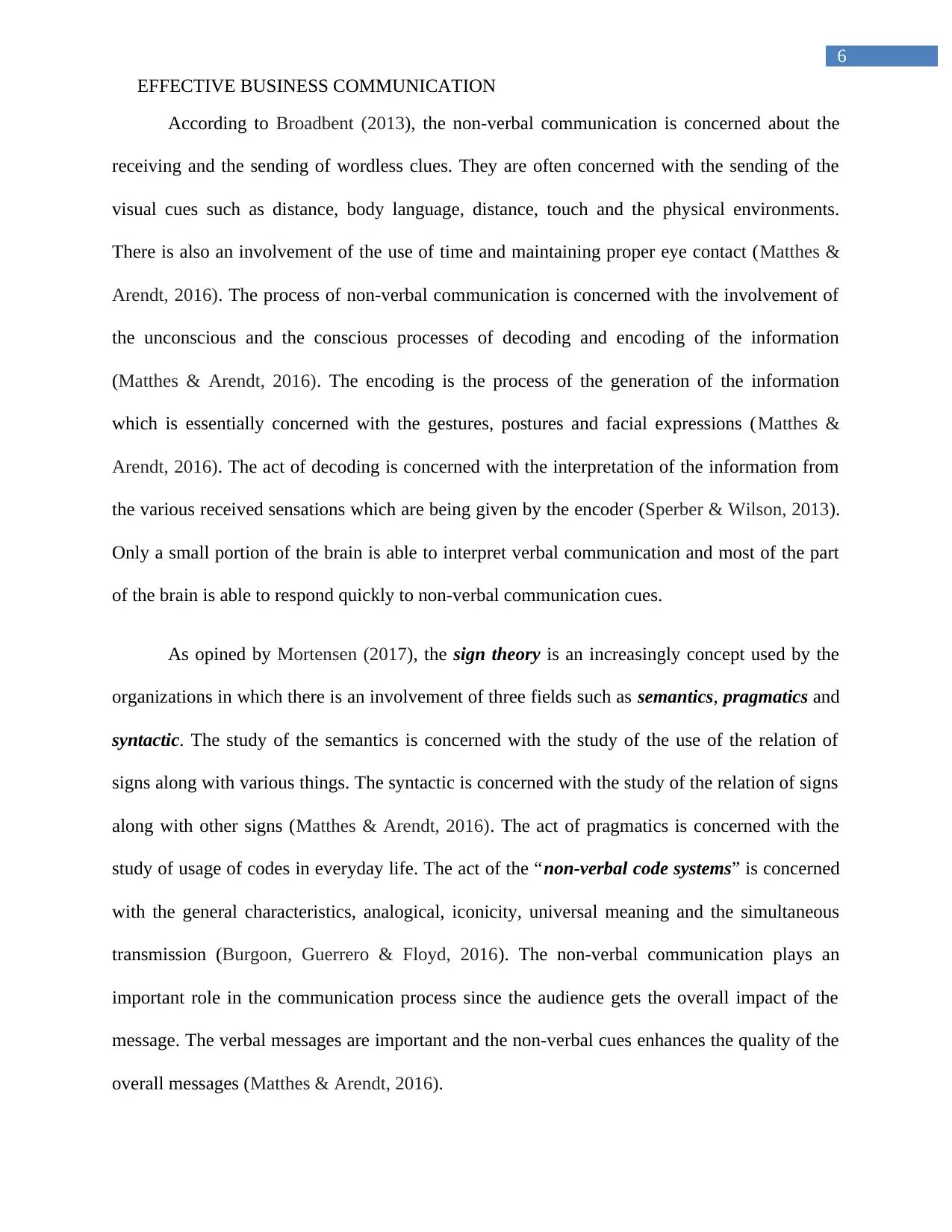
6
EFFECTIVE BUSINESS COMMUNICATION
According to Broadbent (2013), the non-verbal communication is concerned about the
receiving and the sending of wordless clues. They are often concerned with the sending of the
visual cues such as distance, body language, distance, touch and the physical environments.
There is also an involvement of the use of time and maintaining proper eye contact (Matthes &
Arendt, 2016). The process of non-verbal communication is concerned with the involvement of
the unconscious and the conscious processes of decoding and encoding of the information
(Matthes & Arendt, 2016). The encoding is the process of the generation of the information
which is essentially concerned with the gestures, postures and facial expressions (Matthes &
Arendt, 2016). The act of decoding is concerned with the interpretation of the information from
the various received sensations which are being given by the encoder (Sperber & Wilson, 2013).
Only a small portion of the brain is able to interpret verbal communication and most of the part
of the brain is able to respond quickly to non-verbal communication cues.
As opined by Mortensen (2017), the sign theory is an increasingly concept used by the
organizations in which there is an involvement of three fields such as semantics, pragmatics and
syntactic. The study of the semantics is concerned with the study of the use of the relation of
signs along with various things. The syntactic is concerned with the study of the relation of signs
along with other signs (Matthes & Arendt, 2016). The act of pragmatics is concerned with the
study of usage of codes in everyday life. The act of the “non-verbal code systems” is concerned
with the general characteristics, analogical, iconicity, universal meaning and the simultaneous
transmission (Burgoon, Guerrero & Floyd, 2016). The non-verbal communication plays an
important role in the communication process since the audience gets the overall impact of the
message. The verbal messages are important and the non-verbal cues enhances the quality of the
overall messages (Matthes & Arendt, 2016).
EFFECTIVE BUSINESS COMMUNICATION
According to Broadbent (2013), the non-verbal communication is concerned about the
receiving and the sending of wordless clues. They are often concerned with the sending of the
visual cues such as distance, body language, distance, touch and the physical environments.
There is also an involvement of the use of time and maintaining proper eye contact (Matthes &
Arendt, 2016). The process of non-verbal communication is concerned with the involvement of
the unconscious and the conscious processes of decoding and encoding of the information
(Matthes & Arendt, 2016). The encoding is the process of the generation of the information
which is essentially concerned with the gestures, postures and facial expressions (Matthes &
Arendt, 2016). The act of decoding is concerned with the interpretation of the information from
the various received sensations which are being given by the encoder (Sperber & Wilson, 2013).
Only a small portion of the brain is able to interpret verbal communication and most of the part
of the brain is able to respond quickly to non-verbal communication cues.
As opined by Mortensen (2017), the sign theory is an increasingly concept used by the
organizations in which there is an involvement of three fields such as semantics, pragmatics and
syntactic. The study of the semantics is concerned with the study of the use of the relation of
signs along with various things. The syntactic is concerned with the study of the relation of signs
along with other signs (Matthes & Arendt, 2016). The act of pragmatics is concerned with the
study of usage of codes in everyday life. The act of the “non-verbal code systems” is concerned
with the general characteristics, analogical, iconicity, universal meaning and the simultaneous
transmission (Burgoon, Guerrero & Floyd, 2016). The non-verbal communication plays an
important role in the communication process since the audience gets the overall impact of the
message. The verbal messages are important and the non-verbal cues enhances the quality of the
overall messages (Matthes & Arendt, 2016).
Paraphrase This Document
Need a fresh take? Get an instant paraphrase of this document with our AI Paraphraser

7
EFFECTIVE BUSINESS COMMUNICATION
Action Plan
The knowledge gaps need to be enhanced as it would lead to the betterment of the
professional life. I should take appropriate steps to combat the communication challenges so that
there is an improvement of the communication process. I should engage in some steps to make
more verbose communication-
Listening carefully to the other person so that I can know what should I say next
Join public speaking forums and clubs where I would get a variety of people to talk to.
This would eliminate the public speaking embarrassment or fear
Increase my online presence by opening account in multiple social media websites so that
I know the art of expressing my feelings in a clear manner
Background research about the person (with whom I would be communicating) and his
job role would help me to be prepared and hence I would be able to express my feelings
in a more lucid manner
I should also give enough attention to the process of non-verbal communication and I should
strive to improve the same-
Watching myself and my own gestures would allow me to observe other’s non-verbal
cues in a better manner
I should try to maintain proper eye contact with my audience or the other
communicator
Watch interviews of successful persons and observe their non-verbal gestures
Reading the audience and estimating their viewpoints is important
Give attention to the tone of my voice and try to practice speaking in a polite manner
EFFECTIVE BUSINESS COMMUNICATION
Action Plan
The knowledge gaps need to be enhanced as it would lead to the betterment of the
professional life. I should take appropriate steps to combat the communication challenges so that
there is an improvement of the communication process. I should engage in some steps to make
more verbose communication-
Listening carefully to the other person so that I can know what should I say next
Join public speaking forums and clubs where I would get a variety of people to talk to.
This would eliminate the public speaking embarrassment or fear
Increase my online presence by opening account in multiple social media websites so that
I know the art of expressing my feelings in a clear manner
Background research about the person (with whom I would be communicating) and his
job role would help me to be prepared and hence I would be able to express my feelings
in a more lucid manner
I should also give enough attention to the process of non-verbal communication and I should
strive to improve the same-
Watching myself and my own gestures would allow me to observe other’s non-verbal
cues in a better manner
I should try to maintain proper eye contact with my audience or the other
communicator
Watch interviews of successful persons and observe their non-verbal gestures
Reading the audience and estimating their viewpoints is important
Give attention to the tone of my voice and try to practice speaking in a polite manner
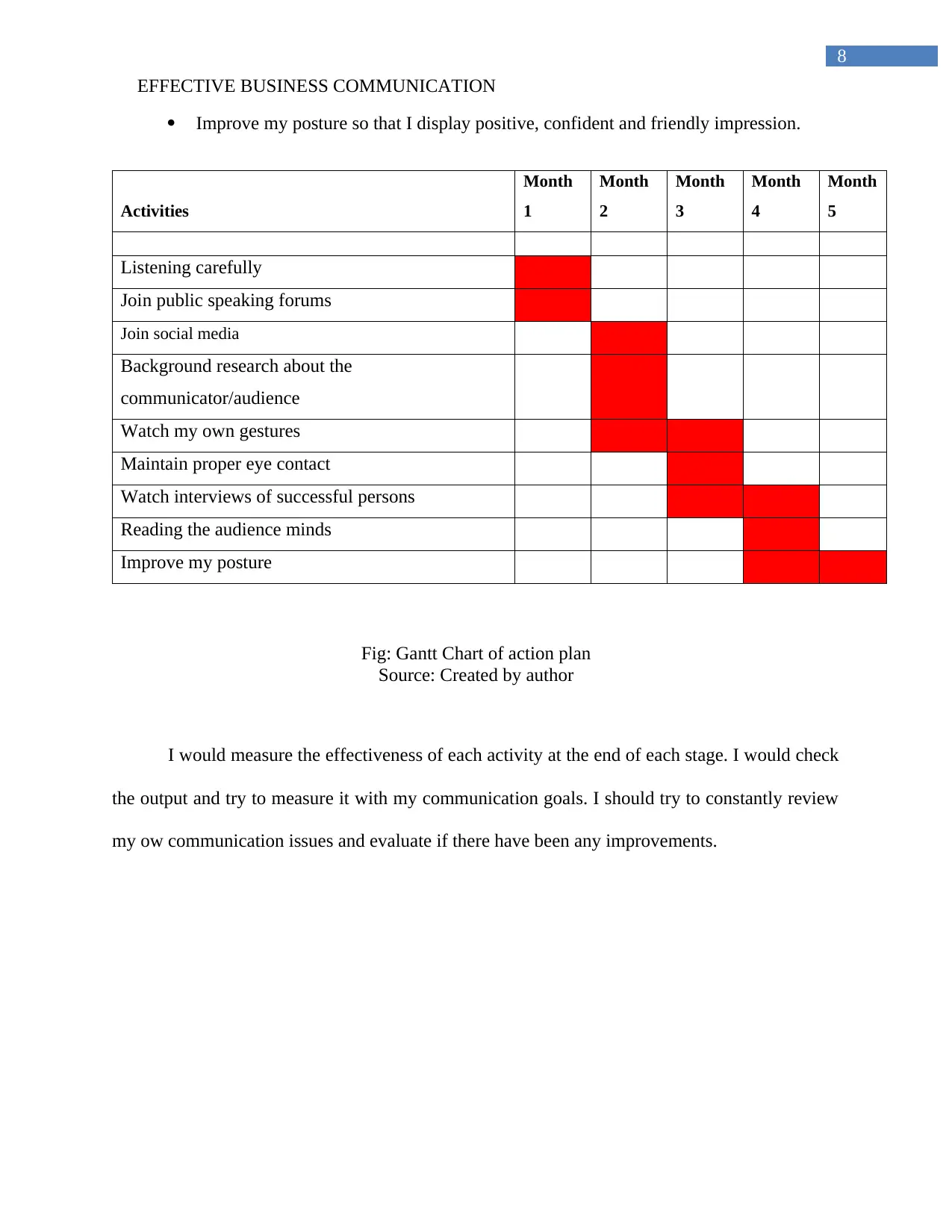
8
EFFECTIVE BUSINESS COMMUNICATION
Improve my posture so that I display positive, confident and friendly impression.
Activities
Month
1
Month
2
Month
3
Month
4
Month
5
Listening carefully
Join public speaking forums
Join social media
Background research about the
communicator/audience
Watch my own gestures
Maintain proper eye contact
Watch interviews of successful persons
Reading the audience minds
Improve my posture
Fig: Gantt Chart of action plan
Source: Created by author
I would measure the effectiveness of each activity at the end of each stage. I would check
the output and try to measure it with my communication goals. I should try to constantly review
my ow communication issues and evaluate if there have been any improvements.
EFFECTIVE BUSINESS COMMUNICATION
Improve my posture so that I display positive, confident and friendly impression.
Activities
Month
1
Month
2
Month
3
Month
4
Month
5
Listening carefully
Join public speaking forums
Join social media
Background research about the
communicator/audience
Watch my own gestures
Maintain proper eye contact
Watch interviews of successful persons
Reading the audience minds
Improve my posture
Fig: Gantt Chart of action plan
Source: Created by author
I would measure the effectiveness of each activity at the end of each stage. I would check
the output and try to measure it with my communication goals. I should try to constantly review
my ow communication issues and evaluate if there have been any improvements.
⊘ This is a preview!⊘
Do you want full access?
Subscribe today to unlock all pages.

Trusted by 1+ million students worldwide

9
EFFECTIVE BUSINESS COMMUNICATION
References
Akdemir, A. S. (2016). The Development and Validation of Willingness-to-Listen in L2 (WTL)
Scale. PASAA: Journal of Language Teaching and Learning in Thailand, 51, 127-154.
Batrinca, L., Stratou, G., Shapiro, A., Morency, L. P., & Scherer, S. (2013, August). Cicero-
towards a multimodal virtual audience platform for public speaking training.
In International Workshop on Intelligent Virtual Agents (pp. 116-128). Springer, Berlin,
Heidelberg.
Berger, J., & Iyengar, R. (2013). Communication channels and word of mouth: How the medium
shapes the message. Journal of Consumer Research, 40(3), 567-579.
Booher, D. (2017). Communicate Like a Leader: Connecting Strategically to Coach, Inspire, and
Get Things Done. Berrett-Koehler Publishers.
Broadbent, D. E. (2013). Perception and communication. Elsevier.
Burgoon, J. K., Guerrero, L. K., & Floyd, K. (2016). Nonverbal communication. Routledge.
Clemente, M., & Roulet, T. J. (2015). Public opinion as a source of deinstitutionalization: A
“spiral of silence” approach. Academy of Management Review, 40(1), 96-114.
Gass, R. H., & Seiter, J. S. (2015). Persuasion: Social influence and compliance gaining.
Routledge.
Jensen, J. V. (2013). Ethical issues in the communication process. Routledge.
Matthes, J., & Arendt, F. (2016). Spiral of Silence. The International Encyclopedia of
Communication Theory and Philosophy.
EFFECTIVE BUSINESS COMMUNICATION
References
Akdemir, A. S. (2016). The Development and Validation of Willingness-to-Listen in L2 (WTL)
Scale. PASAA: Journal of Language Teaching and Learning in Thailand, 51, 127-154.
Batrinca, L., Stratou, G., Shapiro, A., Morency, L. P., & Scherer, S. (2013, August). Cicero-
towards a multimodal virtual audience platform for public speaking training.
In International Workshop on Intelligent Virtual Agents (pp. 116-128). Springer, Berlin,
Heidelberg.
Berger, J., & Iyengar, R. (2013). Communication channels and word of mouth: How the medium
shapes the message. Journal of Consumer Research, 40(3), 567-579.
Booher, D. (2017). Communicate Like a Leader: Connecting Strategically to Coach, Inspire, and
Get Things Done. Berrett-Koehler Publishers.
Broadbent, D. E. (2013). Perception and communication. Elsevier.
Burgoon, J. K., Guerrero, L. K., & Floyd, K. (2016). Nonverbal communication. Routledge.
Clemente, M., & Roulet, T. J. (2015). Public opinion as a source of deinstitutionalization: A
“spiral of silence” approach. Academy of Management Review, 40(1), 96-114.
Gass, R. H., & Seiter, J. S. (2015). Persuasion: Social influence and compliance gaining.
Routledge.
Jensen, J. V. (2013). Ethical issues in the communication process. Routledge.
Matthes, J., & Arendt, F. (2016). Spiral of Silence. The International Encyclopedia of
Communication Theory and Philosophy.
Paraphrase This Document
Need a fresh take? Get an instant paraphrase of this document with our AI Paraphraser
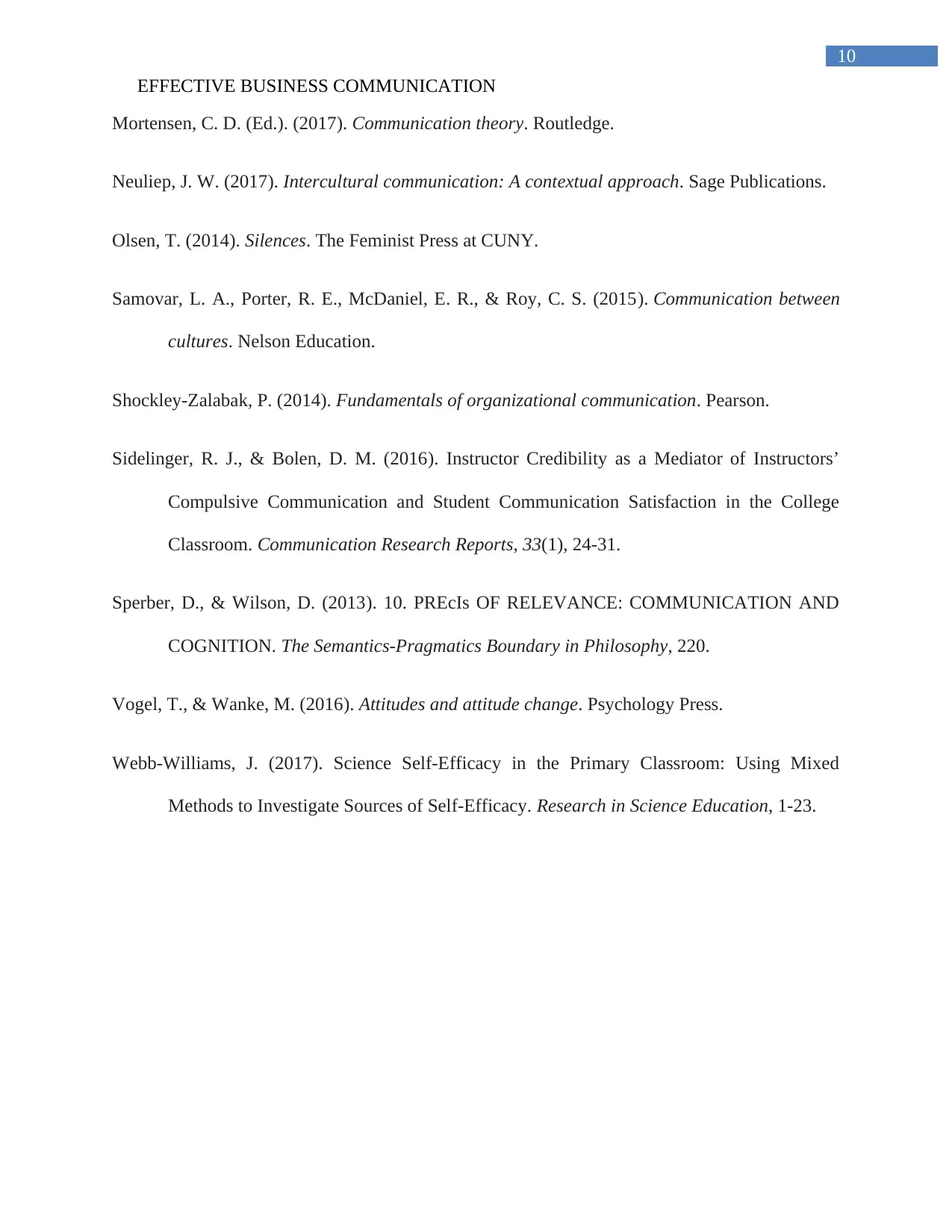
10
EFFECTIVE BUSINESS COMMUNICATION
Mortensen, C. D. (Ed.). (2017). Communication theory. Routledge.
Neuliep, J. W. (2017). Intercultural communication: A contextual approach. Sage Publications.
Olsen, T. (2014). Silences. The Feminist Press at CUNY.
Samovar, L. A., Porter, R. E., McDaniel, E. R., & Roy, C. S. (2015). Communication between
cultures. Nelson Education.
Shockley-Zalabak, P. (2014). Fundamentals of organizational communication. Pearson.
Sidelinger, R. J., & Bolen, D. M. (2016). Instructor Credibility as a Mediator of Instructors’
Compulsive Communication and Student Communication Satisfaction in the College
Classroom. Communication Research Reports, 33(1), 24-31.
Sperber, D., & Wilson, D. (2013). 10. PREcIs OF RELEVANCE: COMMUNICATION AND
COGNITION. The Semantics-Pragmatics Boundary in Philosophy, 220.
Vogel, T., & Wanke, M. (2016). Attitudes and attitude change. Psychology Press.
Webb-Williams, J. (2017). Science Self-Efficacy in the Primary Classroom: Using Mixed
Methods to Investigate Sources of Self-Efficacy. Research in Science Education, 1-23.
EFFECTIVE BUSINESS COMMUNICATION
Mortensen, C. D. (Ed.). (2017). Communication theory. Routledge.
Neuliep, J. W. (2017). Intercultural communication: A contextual approach. Sage Publications.
Olsen, T. (2014). Silences. The Feminist Press at CUNY.
Samovar, L. A., Porter, R. E., McDaniel, E. R., & Roy, C. S. (2015). Communication between
cultures. Nelson Education.
Shockley-Zalabak, P. (2014). Fundamentals of organizational communication. Pearson.
Sidelinger, R. J., & Bolen, D. M. (2016). Instructor Credibility as a Mediator of Instructors’
Compulsive Communication and Student Communication Satisfaction in the College
Classroom. Communication Research Reports, 33(1), 24-31.
Sperber, D., & Wilson, D. (2013). 10. PREcIs OF RELEVANCE: COMMUNICATION AND
COGNITION. The Semantics-Pragmatics Boundary in Philosophy, 220.
Vogel, T., & Wanke, M. (2016). Attitudes and attitude change. Psychology Press.
Webb-Williams, J. (2017). Science Self-Efficacy in the Primary Classroom: Using Mixed
Methods to Investigate Sources of Self-Efficacy. Research in Science Education, 1-23.
1 out of 11
Related Documents
Your All-in-One AI-Powered Toolkit for Academic Success.
+13062052269
info@desklib.com
Available 24*7 on WhatsApp / Email
![[object Object]](/_next/static/media/star-bottom.7253800d.svg)
Unlock your academic potential
Copyright © 2020–2025 A2Z Services. All Rights Reserved. Developed and managed by ZUCOL.




